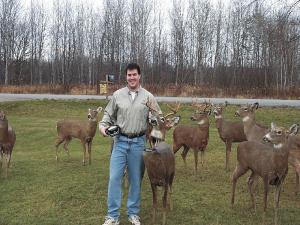2002 - Volume #26, Issue #5, Page #44
[ Sample Stories From This Issue | List of All Stories In This Issue | Print this story
| Read this issue]
Robotic Decoys Help Hunters, Catch Poachers
 |
Wolslegel creates life-like, robotic decoys controlled by hand-held remotes. He collects several hundred hides each year from deer hunters and transforms them into moving decoys equipped with a robotic head and tail. If desired, one of the legs can be made to stomp up and down. Removable antlers allow the deer to be used as a buck or doe, and the head can be removed for transport.
All moving parts are operated by separate motors controlled by switches on the remote control.
Besides white-tail deer, Wolslegel also offers robotic black-tail deer, mule deer, turkeys, coyotes, fox, elk, grouse, grizzly bears, black bears, mountain lions, pheasants, moose and big horn sheep.
His motorized decoys, which he markets under the name of Custom Robotic Wildlife, are used both by game wardens and by private landowners to catch poachers. He has clients in 48 states, Canada and Argentina. "As far as I know, I'm the only full-time manufacturer of motorized wildlife in the U.S.," says Wolslegel. "Game wardens have used stationary wildlife decoys to curb poaching for years. However, my motorized decoys are much more lifelike. The average deer decoy normally lasts about two to three years, depending on how often poachers decide to take a shot at it."
Game wardens and hunters aren't his only customer. "Some ĉentertainment farms' that offer hay and sleigh rides use the deer as attractions, placing it in the woods."
Wolslegel says his fastest growing motorized decoys are turkeys, largely because of the increasing popularity of hunting wild turkeys. "I can make the tail go up and down and use a fan to ruffle the feathers. The only shortcoming of the turkey decoy is its longevity. It's important to place the decoy just out of range to avoid a direct hit."
According to Wolslegel, his decoys can play an important role in curbing illegal hunting. A single robotic deer decoy is capable of helping game wardens collect $20,000 to $30,000 in fines, he says.
He's continually making improvements and recently finished mounting a robotic deer on an 8-ft. long track so that it's able to move through woods or grass. He did the same thing with a wild pig for the Texas wildlife department.
The white tail deer decoy is mounted on a form that represents a 130 to 140-lb. animal. However, the actual weight of the decoy is only about 20 lbs. A white-tail deer, including robotic head, tail, and removable antlers, sells for $850. Add $25 for packaging and crating and $130 to $160 for shipping. An extra large decoy - and a laying down deer - are available for an additional $200.
The elk weighs about 150 lbs., but the head and legs can be removed making it easier to handle. An elk with robotic head, removable legs, and antlers sells for $2,100.
The turkey decoy with a robotic head sells for $625; with robotic head and swivel base, it sells for $800.
Contact: FARM SHOW Followup, Custom Robotic Wildlife, Inc., 839 Oak Road, Mosinee, Wis. 54455 (ph 715 692-3000; fax 715 692-3003; E-mail: brian@wildlife decoys.com; Website: www.wildlifedecoys. com).

Click here to download page story appeared in.

Click here to read entire issue
To read the rest of this story, download this issue below or click here to register with your account number.




